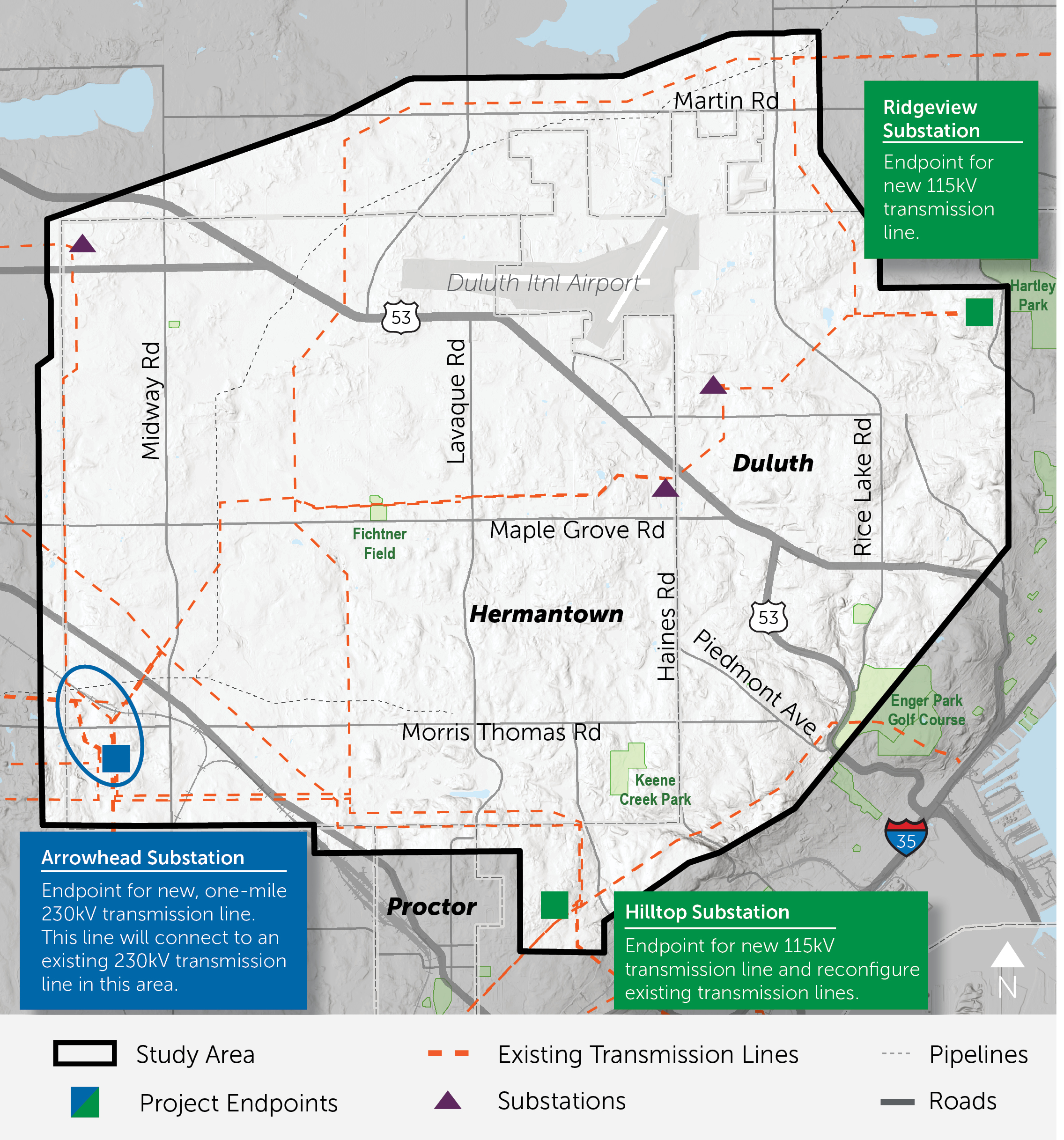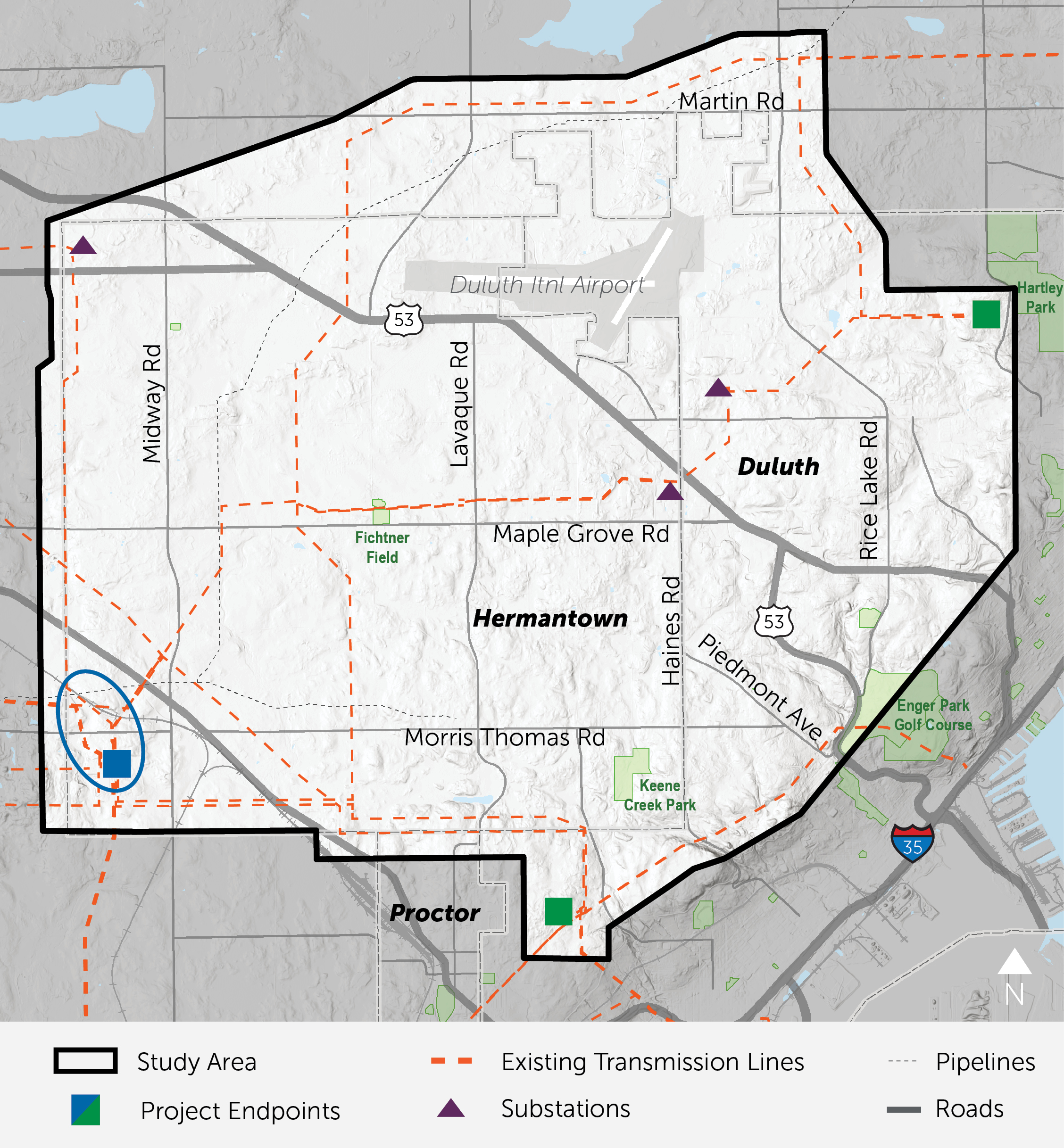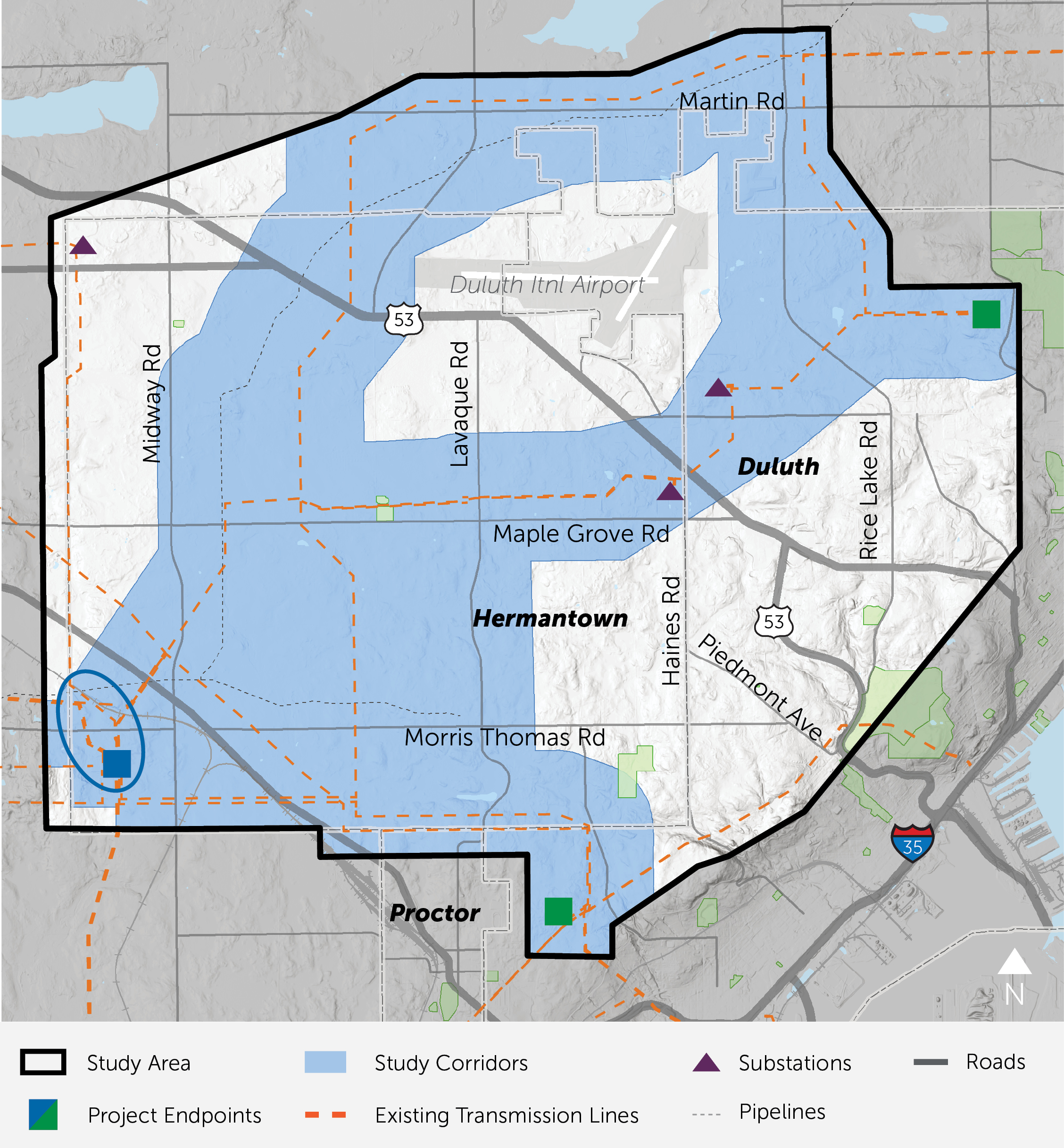Engagement Opportunities
Virtual Community Meeting
Thursday, January 28 at 12:00pm or 7:00pm
- Watch the project team give a brief presentation followed by a Q&A session
- Full details at duluthloop.com
- Register for the 12:00pm Meeting
- Register for the 7:00pm Meeting
Live Chats
Project team staff will be available for live 1:1 chats in this Virtual Open House during the following times:
- Tuesday, January 26th from 12:00pm – 1:00pm
- Wednesday, January 27th from 4:30pm – 6:00pm
- Friday, January 29th from 7:30am – 9:00am
Information Packets
Call 218-755-5512 or email connect@duluthloop.com to request mailed project information packet.
Packets can also be found at DuluthLoop.com
Schedule a Call
Discuss the project and your interests with the project team. To schedule call 218-755-5512 or email connect@duluthloop.com.
To prevent the further spread of COVID-19, Minnesota Power has indefinitely postponed all in-person public meetings and events. Public engagement remains a top priority for our project team and we appreciate you joining us online to learn more about this project.
Our Commitment to Reliable Energy
Minnesota Power has made significant changes to our generation mix including the retirement of several small coal units. In order to maintain a continuous supply of safe and reliable electricity, we are investing in transmission infrastructure to enhance the stability of our electric system in our communities.
Click on the items below to learn more about energy reliability.+What happens when we reduce coal generation?

When we retire coal plants we must do more than just replace the energy they once generated. We must also find ways to replace the reliability and strength they provided to the grid.
+How do we maintain reliability?

When large generators – like coal plants – retire, we must find ways to make sure the grid remains stable by:
- Adding other generation sources in the appropriate locations
- Adding more transmission lines to create redundancy
+What do we mean by redundancy?

Additional transmission lines allow for the desired amount of energy to move between regions and ensure that energy needs are met for all hours of the year. They will also mitigate some of the negative impacts that large facility retirements have on system stability and reliability.
+Why the Duluth Loop Reliability Project?

As Minnesota Power and its customers continue transitioning from coal-fired generators to lower-carbon sources of energy, transmission projects like the Duluth Loop Reliability Project are needed to ensure continuous safe and reliable operations of the transmission system in the midst of this energy transition.
Project Overview
This project will enhance reliability by building an additional transmission source to communities in and around Duluth and along the North Shore.
Project Components
- Construction of a new 115 kilovolt (kV) transmission line between the Ridgeview and Hilltop substations
- Construction of approximately one-mile extension of an existing 230kV transmission line, connecting to the Arrowhead Substation
- Upgrades to the Ridgeview, Hilltop, and Arrowhead substations

Click on the image to enlarge.
Local and Regional Benefits
The Duluth Loop Reliability Project is about more than just providing power. This project will:
ENHANCE ENERGY RELIABILITY
for communities in Duluth and the North Shore by adding transmission in the area
REPLACE GRID STRENGTH AND STABILITY
that was once provided by local coal-fired generation
Our grid is interconnected and additional areas will benefit due to a strong, reliable grid. Minnesota Power customers throughout the blue shaded area will directly benefit from the Duluth Loop Reliability Project.
Project Timeline
The planning, development and construction schedule is subject to change based on weather, the availability of equipment and materials, the impact of COVID-19 and other potentially unforeseen events.
Routing Process
Curious how we route a new transmission line? It’s a collaborative process. Here’s our typical routing process phases. Click on the steps below to learn more about the routing process.
Define Study Area (November - December 2020)
- Development of Routing Criteria and identification of Project parameters
- Identification of Study Area
- Review of publicly available information
- Initial meetings with key stakeholders and local leaders
Define Study Corridors (January – February 2021)
- Evaluation of Stakeholder input
- Development of Study Corridors
- We are here!Phase 1 Public Engagement – present Study Corridors
Define Route Options (March – April 2021)
- Evaluate input received from public engagement
- Development of Route Options
- Phase 2 Public Engagement – present preliminary Route Options
Identify Preferred Route (April - June 2021)
- Evaluate input received from public engagement
- Select Preferred Route
Routing Considerations
Our goal is to take advantage of Opportunities while understanding and minimizing impacts to Sensitivities and addressing Constructability concerns. We use these three categories to develop a Preferred Route.
+OPPORTUNITIES

- Existing transmission lines
- Roadways/trails
- Railroads
- Public Land Survey System (e.g. section lines, half-section lines, etc.)
- Property lines (legal divisions of land)
- Natural division lines (e.g. field boundaries)
- Pipelines
+SENSITIVITIES

- Federal/State/County resources
- Non-governmental Organizations (NGOs) lands
- Airports/VOR
- Special status species/habitat
- Cultural resources
- Special jurisdictions
- Visual resources
- Public infrastructure
- Natural resources
- Parks/recreation areas & trails
- Community centers
- Assisted living/nursing homes
- Greenfields (new corridors in undeveloped areas)
+CONSTRUCTABILITY

- Endpoint locations
- Line length
- Cost
- Terrain/soil conditions
- Roadway access to route/construction areas
- Specialty structures
- Angle structures
- Foundation size/type
- Inductive current/interference
- Reliability
- Tree trimming/vegetation management
Input Opportunity - Sensitivities
Select the top three Sensitivities that are most important to you and click “submit” at the bottom of this page. Reminder: Sensitivities are resources or conditions that can potentially limit transmission line development.
Study Corridors
Minnesota Power developed the Study Area and Study Corridors to meet the needs of the Project. The Study Area was delineated to include the project endpoints (project substations) and routing opportunity features found between the endpoints, such as existing transmission lines and other linear infrastructure. These existing features have been highlighted as Study Corridors. In March 2021, Route Options will be developed within this Study Area and along the Study Corridors
Study Area

Click on the image to enlarge.
Study Corridors

Click on the image to enlarge.
Input Opportunity - Comment on the Corridors
Now that you’ve learned about the project, routing process and criteria and how the Study Corridors were identified, we’d like your input to help our project team identify additional Opportunities and Sensitivities. Use the map below to review the Study Corridors. If you would like to provide feedback on a particular area, click the Add Comment button.
For best results, view map in Chrome, Firefox, or Edge.Study Area
Study Corridors
115kV Project Endpoint
230kV Project Endpoint
Substations
Detailed Study Corridor Maps
Click or tap on the numbered squares below to view a detailed pdf map of that area.
For best results, view map in Chrome, Firefox, or Edge.Agency and Tribal Coordination
Our project team coordinates with Federal, state, and local agencies and tribal representatives regarding protected or sensitive resources in a study area when siting a new transmission line to learn about route opportunities and sensitivities.
Sometimes additional permits or approvals from these agencies are necessary to construct a project. We'll be coordinating to learn permit and survey requirements
Federal
- US Fish and Wildlife Service
- Federal Aviation Administration
- US Army Corps of Engineers
- Environmental Protection Agency
State
- Public Utilities Commission
- Department of Commerce
- Department of Transportation
- Department of Natural Resources
- State Historic Preservation Office
- Pollution Control Agency
Local
- St. Louis County
- City of Duluth
- City of Hermantown
- City of Proctor
- City of Rice Lake
- Canosia Township
- Midway Township
- Solway Township
Tribal
- Bois Forte Band of Chippewa
- Red Lake Nation
- White Earth Nation
- Mille Lacs Band of Ojibwe
- Leech Lake Band of Ojibwe
- Fond du Lac Band of Lake Superior Chippewa
- Grand Portage Band of Lake Superior Chippewa
Structure Design
The structure types and specifications shown below are preliminary and subject to change. Other structure types may be used depending on final route location.
Typical 115kV Structures
Click on the image to enlarge.
- Typical Height: 50 - 80 feet (ft)
- Typical Span: 500 - 1,000ft
- Foundation type: Direct embed
- Typical Right-of-way: 100ft
Typical 230kV Structures
Click on the image to enlarge.
- Typical Height: 60 - 100 feet (ft)
- Typical Span: 500 - 1,000ft
- Foundation type: Direct embed
- Typical Right-of-way: 130ft
Paralleling Structures
In the event that the new 115kV transmission line parallels an existing 115kV transmission line, the alignment of typical right-of-ways may look similar to what's shown in the diagram below. Different dimensions would apply for a 115kV line paralleling a 230kV line. Learn more about right-of-way and real estate in the next slide.
Click on the image to enlarge.
The structure figures shown here are wood pole H-Frame tangent type structures which are anticipated to be common on new lines. Less common structure configurations including but not limited to deadends, angles, crossings, transpositions, and double circuits may also be necessary and may consist of wood pole, guyed wood pole, or steel pole type structures not pictured here. Typical structure heights and spans indicate the average expected values for the majority of structures of this type based on similar facilities. Actual heights and spans are a function of structure type, wire type, wire tension, voltage, route, and topography. Actual span lengths and structure heights may vary outside typical values as necessary.
Real Estate
Following the Public Utilities Commission’s approval of the final route (anticipated November 2022), notification letters will be mailed to all landowners along the final route.
Landowner Conversations
Project representatives will hold individual meetings with affected landowners to discuss the project and right-of-way needs. Discussion topics during these meetings include:
- Land surveys and studies
- Proposed easement
- Right-of-way clearing
- Type(s) and number of structures
- Compensation
- Property restoration
- Damage settlements
What is right-of-way?
The term right-of-way (abbreviated 'ROW') is typically a strip of land used for a specific purpose such as the construction, operation, and maintenance of a transmission line.
What is an easement?
A legal agreement allowing Minnesota Power the right to construct, operate and maintain a transmission line on your property.
Preconstruction and Construction
Once a final route has been approved and easements have been agreed upon, preconstruction and construction activities will begin.
Preconstruction Activities
Prior to construction, a number of activities must occur including:
- Field Surveys
- Wildlife Surveys
- Archaeological Surveys
- Wetland and Stream Surveys
- Soil Surveys
Construction Activities
After permitting, right-of-way acquisition, and final design, the new transmission lines will be constructed by qualified contractors. Here are the typical components of construction anticipated for the Duluth Loop Reliability Project.
Initial surveying, right-of-way clearing, and access development
Structure staking, surveying, and soils investigations as needed
Foundation installation
Foundation type may vary depending on structure.
Assemble and set structures
Wire installation
Clean up and restoration
Stay Updated & Contact Us
Thank you for your interest in the Duluth Loop Reliability Project!
All input will be reviewed and considered by the project team while developing the Route Options.
Please submit your comments by February 5, 2021.
Stay in touch
- Visit duluthloop.com to join our project mailing list. Be sure to sign up for updates to be informed of scheduled engagement opportunities. Email subscribers will be the first to know about events and other ways to be involved in the project.
- Call our Hotline at 218-755-5512
- Email us: connect@duluthloop.com
Share your thoughts
Submit a comment by clicking on the Comment button at the top of your screen.